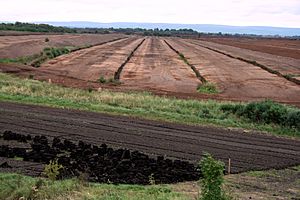Bog of Allen facts for kids

The Bog of Allen (which is Móin Alúine in Irish) is a very large raised bog located in the middle of Ireland. It sits between two important rivers, the River Liffey and the River Shannon.
This huge bog covers about 958 square kilometers (370 square miles). It stretches across several counties: County Offaly, County Meath, County Kildare, County Laois, and County Westmeath. A government company called Bórd na Móna uses machines to harvest peat (also known as turf) from the bog on a large scale. This peat is then used as fuel. There are many miles of special narrow gauge railway tracks in the area. These tracks help transport the peat to processing factories and power plants that use turf for energy. Some parts of the bog that have already been harvested are now used for grazing animals. Two important canals, the Grand Canal and the Royal Canal, also cross through the bog.
Contents
Protecting the Bog of Allen
The Irish Peatland Conservation Council says the Bog of Allen is a very important part of Ireland's natural history. They compare its importance to the famous Book of Kells. Over many centuries, a lot of the bog has been used for industry. Also, new buildings and developments have taken over some areas. Because of this, many groups are now working hard to protect and save parts of the bog for the future.
Discoveries from the Past
The peatlands of the Bog of Allen are like a giant time capsule! They hold many valuable archaeological finds. Because of the special conditions inside peat, many ancient objects that usually decay, like wooden structures and tools, are kept safe.
As machines harvest peat in different parts of the Bog of Allen, they often uncover old remains. For example, they have found ancient trackways. These were wooden paths built long ago, from prehistoric times up to the medieval period. People and animals used these paths to cross the wide, wet peatlands. These discoveries give us clues about how people lived and what their economy was like around the bog thousands of years ago.
The bog also preserves tiny pieces of ancient plants and pollen. Scientists study these to learn about the environment and climate that existed around the bog in the past.
Studying Ancient Environments
Many scientific studies have focused on the Bog of Allen to understand what past environments were like. Scientists do this by studying things preserved in the bog, which are called "palaeoenvironmental proxies." Bogs like the Bog of Allen are especially interesting because they are very sensitive to changes in rainfall. This means they can tell us a lot about past climates.
One ongoing study on Daingean Bog is using tiny organisms called testate amoebae. These tiny creatures help scientists figure out how much rain fell in the past. They can also link these changes in rainfall to bigger climate shifts that happened during the Holocene period (the last 11,700 years). These studies are very useful because they can help us understand how ancient societies reacted to changes in their climate.
Images for kids
See also
In Spanish: Bog of Allen para niños




